Types of Redbud Trees: Eastern, Western, Chinese, and More (Pictures)
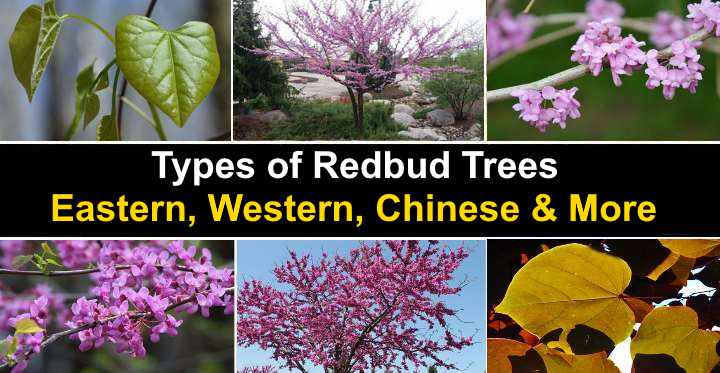
Redbud trees are beautiful small trees with striking pink or white spring flowers. Redbud trees have heart-shaped leaves, and dark maroon or brown seedpods. Redbuds look stunning in any season due to their colorful foliage and showy blooms. In summer redbud leaves are green and then become yellow, orange or red during autumn.
Redbud trees are small, deciduous trees or large shrubs that are native to eastern North America. Redbuds grow to between 20 and 30 ft. (6 – 9 m) and have a short trunk with spreading branches. The trees are famous for their bright flowers, glossy foliage, and dark-colored winter buds.
Redbud trees are in the plant family Fabaceae and the genus Cercis. There are 10 redbud varieties in the genus Cercis. The four main varieties of redbuds are the Eastern Redbud (Cercis canadensis), Chinese Redbud (Cercis chinensis), Western Redbud (Cercis occidentalis), and Judas tree or European redbud (Cercis siliquastrum).
How to Care For Redbud Trees
Redbud trees thrive when planted in full sun or partial shade. This colorful tree, with its rounded crown, requires regular watering and well-draining soil. Its spectacular pink flowers blossom best in full sun. In hot climates, plant redbud trees in partial shade for best results.
This guide to redbud trees describes the most common types of redbud trees. Pictures of redbuds and descriptions will help you choose the ideal variety of tree for your front or backyard.
Redbud Flowers
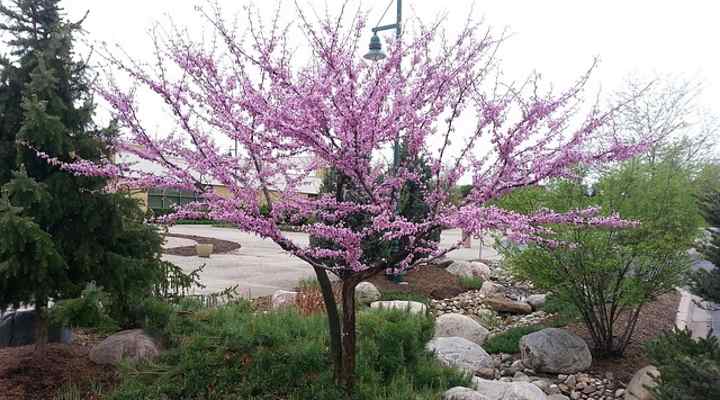
Redbud flowers come in various shades of pink color
Redbud flowers range in color from light pink to dark magenta and even white. The small pink redbud flowers appear in spring on leafless twigs. The small clusters of rosy pink redbud flowers grow the length of the branches. When redbud flowers are in bloom, the flowering tree looks like a breathtaking mass of pink blossoms.
The flowers and fruits of redbud trees are unique in that they grow on bare branches.
Redbud Leaves
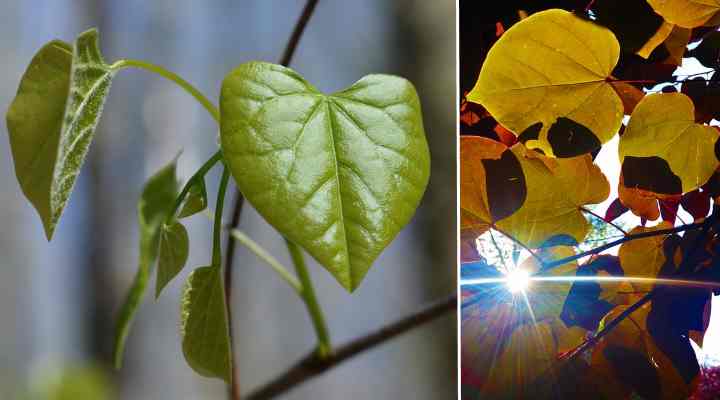
Redbud leaves in summer (left) and fall (right)
Redbud leaves look like green hearts that are 3” to 5” (7 – 12 cm) wide and long. Redbud leaves are simple heart-shaped blades growing alternately on thin stems. During the fall, the green leaves turn magnificent hues of yellows, oranges, and reds.
The Best Redbud Varieties for Your Garden
Redbuds are generally identified by their pink flowers and heart-shaped leaves. Many cultivars in the redbud species Cercis canadensis have variations of flower colors and tree size. Varieties of redbud can have light pink, white, or dark pink flowers.
Here are some of the best varieties of redbud trees to plant in your yard:
- Ruby Falls redbud is a small weeping tree with reddish-purple flowers. This redbud has leaves that are a deep red or burgundy color that turns green in summer.
- Forest Pansy redbud is a popular multi-stemmed tree with small pink flowers. Its heart-shaped leaves turn to attractive shades of bronze, red, burgundy, or orange in the fall.
- Ace of Hearts redbud is a dwarf redbud tree with stunning purple-reddish flowers that is ideal for small gardens.
- ‘Merlot’ redbuds are compact trees with cheerful pink flowers and shiny red and green leaves. This eastern redbud adds elegance to any garden.
- ‘Texas White’ redbud has brilliant white flowers with shiny green foliage.
Types of Redbud Trees
Let’s look in more detail at some of the most popular redbud trees. At the end of the article, you’ll find some care tips for the most common redbud trees.
Here are some of the many types of redbud trees:
Eastern Redbud (Cercis canadensis ‘Canadensis’ or Cercis canadensis L)
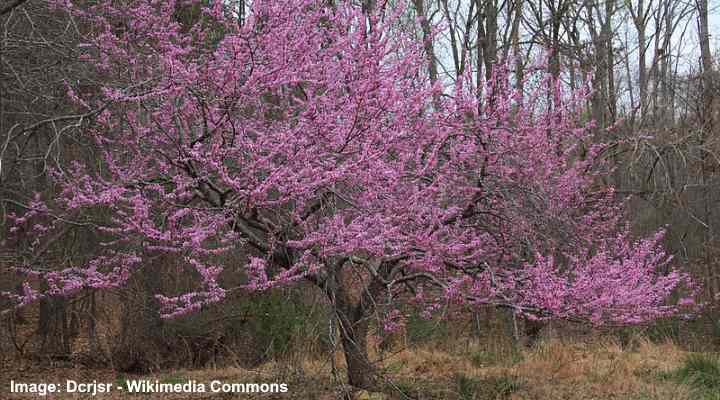
Eastern redbud (American redbud) tree with pink flowers
Eastern redbuds bloom with masses of rosy-pink flower clusters in spring. This common redbud variety is a multi-stemmed tree, growing to between 20 and 30 ft. (6 – 9 m) tall. The rounded crown and glossy reddish-green heart-shaped leaves look spectacular in any small or large garden.
Also called the American redbud, the Eastern redbud is perfect as a specimen flowering tree. Grow in full sun to partial shade, plant in well-draining soil, and water regularly during the growing season. Eastern redbuds grow in zones 4 – 9.
Redbud leaves
Eastern redbuds have bright green, heart-shaped leaves with a hint of red. The redbud leaves become pale yellow in the fall.

Eastern redbud leaves
Redbud flowers
Eastern redbud tree flowers are small pea-like flowers growing in clusters. The rosy-pink or purplish-pink flowers cover bare branches. The spectacular pink flowers bloom in April and add eye-catching colors to garden landscapes.
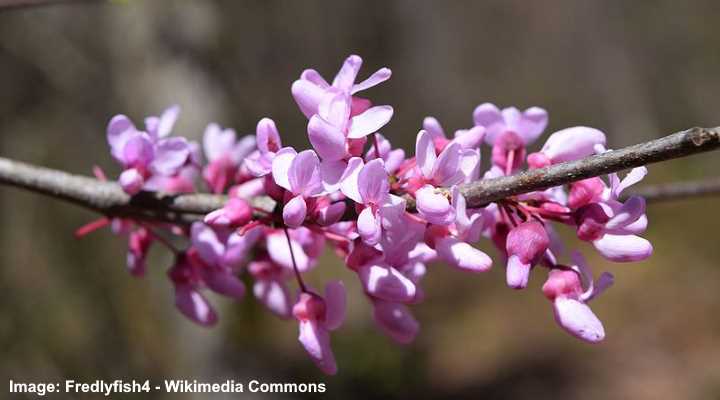
Eastern redbud flowers
Dwarf Weeping Lavender Twist Redbud (Cercis canadensis ‘Covey’)

Weeping Lavender Twist Redbud (‘Covey’ redbud)
The weeping lavender twist (Eastern redbud cultivar ‘Covey’) is a dwarf tree with drooping branch growth. This weeping dwarf redbud tree looks like an umbrella due to the arching pendulous branches. Small pea-like lavender-colored flowers grow in clusters, covering the droopy twigs. The fast-growing lavender twist redbud grows to between 5 and 15 ft. (1.5 – 5 m) tall.
Grow lavender twist redbud trees as foundation plants, small specimen weeping trees, or shrub borders. As with most North American native redbud species, these trees grow best in full sun or partial shade for spectacular blooming in spring.
Redbud leaves
Eastern redbud ‘Covey’ tree leaves are broad and heart-shaped. The redbud leaf foliage is a bright green color with a few purple leaves adding interest to the small weeping tree’s domed shape.
Redbud flowers
Lavender twist redbud trees have showy pink flowers that bloom in early spring.
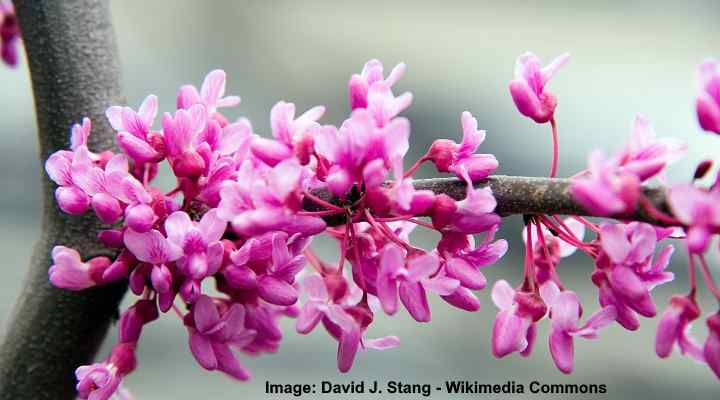
‘Covey’ redbud flowers
Texas Redbud (Cercis canadensis ‘Texensis’)

Texas redbud tree
Texas redbuds are a multi-stemmed tree-like shrub with a rounded crown and showy rose-purple flowers. Texas redbuds have wide, spreading branches that have deep pink flowers in spring. Native to Texas, these redbuds thrive in zones 6 – 9, growing in full sun and well-drained fertile ground.
The Texas redbud is a more drought-tolerant tree than other redbud varieties. It also has brighter flowers than other redbuds. Compared to other redbuds, the ‘Texensis’ species has a more compact growth habit.
The Texas redbud (Cercis canadensis ‘Texensis’) is Oklahoma’s state tree, where it transforms landscapes in spring with its purple-pink flowers.
Redbud leaves
Texas redbuds have dull green leaves that are more kidney-shaped than heart-shaped. The thick leaves are rounded without having a pointed tip that is typical of most redbud varieties.

Texas redbud leaves
Redbud flowers
Texas redbud trees bloom with bright rose or wine-colored flowers in March and April.
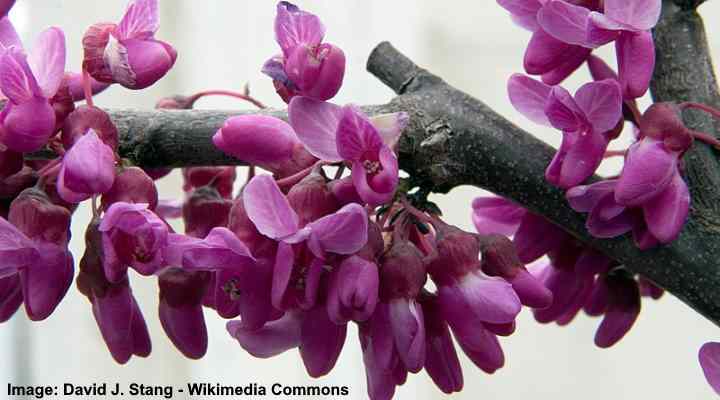
Texas redbud flowers
Oklahoma Redbud (Cercis canadensis var. texensis ‘Oklahoma’)
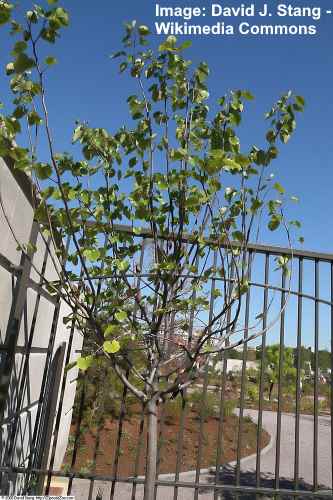
Oklahoma redbud tree
Oklahoma redbud trees are a compact variety of the ‘Texensis’ tree. Oklahoma redbuds have dark magenta flowers and rich, glossy-green waxy heart-shaped leaves. Oklahoma redbud trees have a more rounded look than Texas redbuds. Plant these small redbuds in full sun as specimen trees, foundation plantings, or shrub borders.
Mexican Redbud (Cercis canadensis ‘Mexicana’)
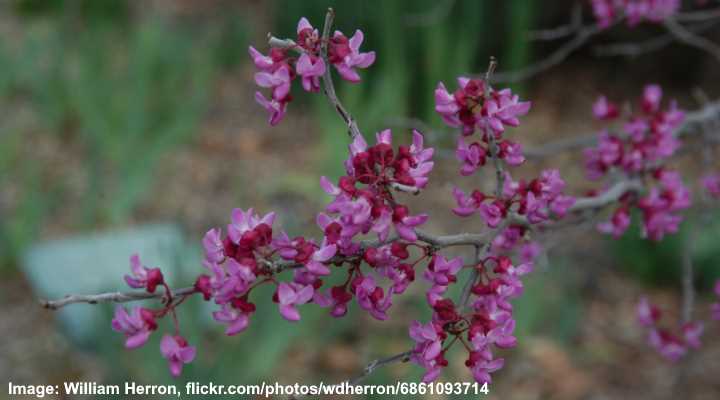
Mexican redbud flowers
Mexican redbud is a small tree with purple flower clusters and green leaves. Mexican redbud tree grows to between 5 and 12 ft. (1.5 – 3.5 m). Compared to Texan redbuds, the Mexican variety is more drought-tolerant and thrives in full sun. Mexican redbuds are stunning ornamental landscape trees for small gardens.
Mexican redbuds grow in zones 6 – 9.
Redbud leaves
Mexican redbud trees have glossy green, heart-shaped leaves with a wavy edge. The simple leaves grow in an alternate arrangement on stems.
Redbud flowers
Mexican redbud flowers are wine-red showy blossoms that appear in clusters in early spring.
Cercis canadensis ‘Forest Pansy’ Redbud
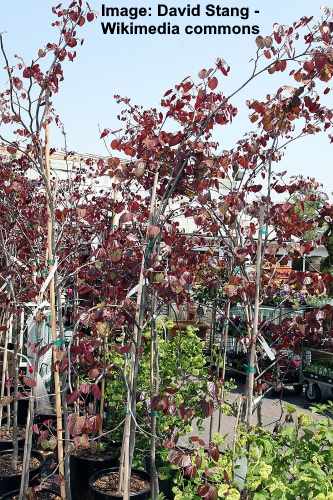
‘Forest Pansy’ redbuds – young trees
Redbud ‘Forest Pansy’ trees have striking colorful foliage and pea-like pink flowers. ‘Forest Pansy’ redbuds are attractive landscape trees with year-round interest. In spring, the redbud looks rosy-pink when in bloom. Then in summer, its reddish leaves turn dark green. In the fall, the heart-shaped leaves turn orange or bronze.
‘Forest Pansy’ redbud trees are ideal as ornamental specimen plants for your backyard. These Eastern redbud varieties grow to between 20 and 30 ft. (6 – 9 m) tall. Low-maintenance, ‘Forest Pansies’ grow easily in full sun and well-draining soil. Ideal for growing in zones 5 – 9.
Redbud leaves
‘Forest Pansy’ redbuds have colorful heart leaves with a different color in each of the seasons.
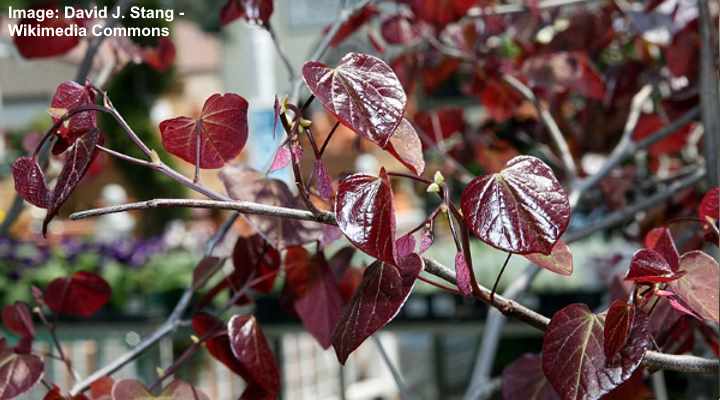
Redbud ‘Forest Pansy’ leaves
Redbud flowers
Redbud ‘Forest Pansy’ blossoms are small, dainty clusters of flowers in varying pink shades.
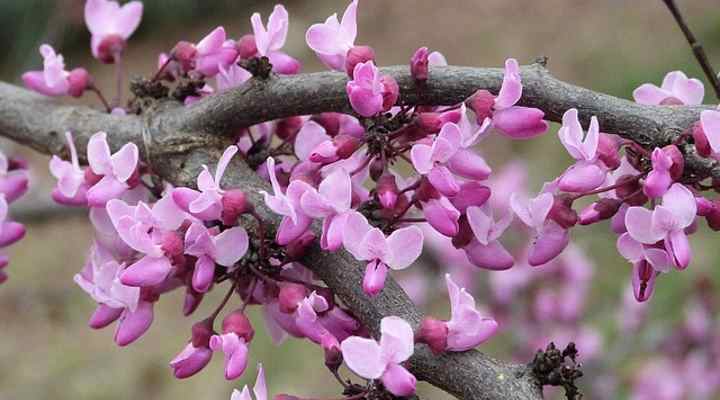
Redbud ‘Forest Pansy’ flowers
Cercis canadensis ‘Hearts of Gold’ Redbud
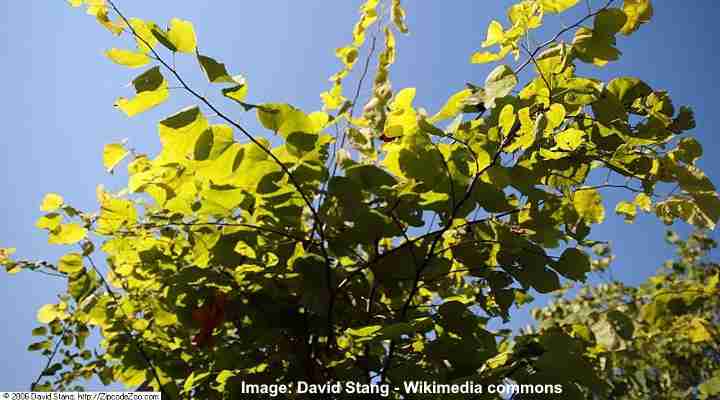
Eastern redbud ‘Hearts of Gold’
Eastern redbud ‘Hearts of Gold’ is a dense tree with rounded growth. ‘Hearts of Gold’ redbuds have leaves that are a bright gold color in summer. The lush foliage and low growth habit make this redbud variety ideal as a privacy hedge or specimen plant. Grow in zones 5 – 9.
‘Hearts of Gold’ redbud trees flower best when grown in a sunny spot in your yard. The dome-shaped canopy of this redbud species grows up to 10 ft. (3 m) tall.
Redbud leaves
‘Hearts of Gold’ redbuds have brightly colored greenish-gold leaves that withstand full sun.
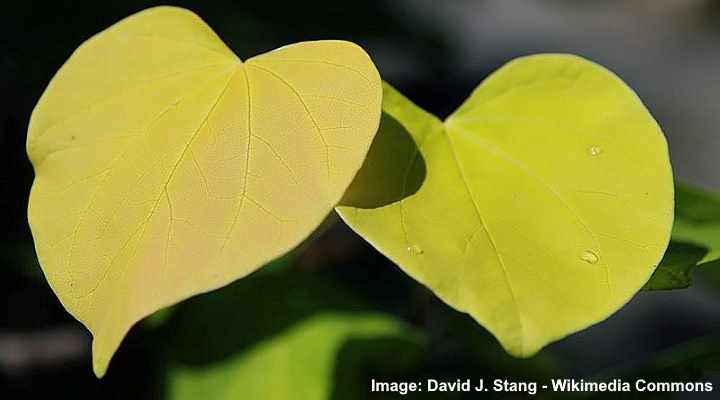
Eastern redbud ‘Hearts of Gold’ leaves
Redbud flowers
Redbud ‘Hearts of Gold’ tree flowers are small lavender-purple blossoms that create dramatic garden displays when they bloom.
Eastern Redbud ‘Tennessee Pink’ (Cercis canadensis ‘Tennessee Pink’)
‘Tennessee Pink’ redbuds have dense foliage, pink flowers, a rounded shape, and irregular branching. The redbud variety ‘Tennessee Pink’ is a small tree that reaches up to 20 ft. (6 m) tall and adds elegance to residential gardens. Showy pink flowers emerge in spring before heart-shaped dark green flowers cover the tree. ‘Tennessee Pink’ redbuds turn yellow in the fall.
Grow ‘Tennessee Pink’ Eastern redbud trees in zones 5 – 9 and in moist, well-drained soil where they get six hours of sunshine daily.
Redbud leaves
Eastern redbud ‘Tennessee Pink’ tree leaves are the typical heart shape of redbud trees.
Redbud flowers
‘Tennessee Pink’ redbud flowers are pink and grow in clusters that cover the tree’s irregular branches. The flowers on this redbud variety grow best in full sun but need some shade in hot climates.
Cercis canadensis ‘Ace of Hearts’ (Eastern Redbud)
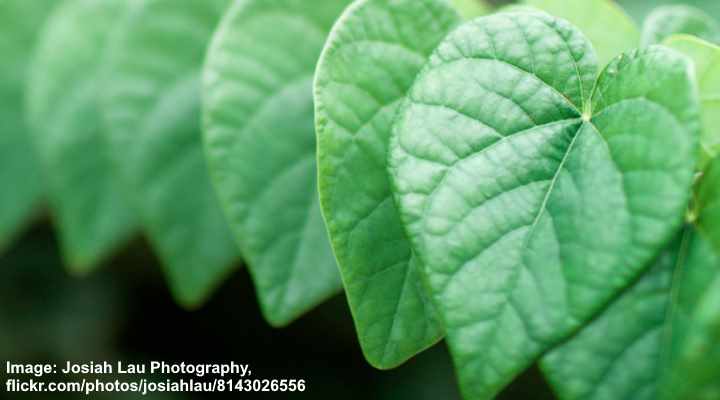
Redbud ‘Ace of Hearts’ leaves
Redbud ‘Ace of Hearts’ is a compact, multi-stemmed tree with reddish-purple flowers. ‘Ace of Hearts’ redbuds bloom in early spring for three weeks. The semi-glossy dark green foliage creates privacy and shade in the summer. In fall, the leaves of ‘Ace of Hearts’ redbuds turn spectacular shades of yellow.
Easy growing redbud ‘Ace of Hearts’ thrive in zones 5 – 9. The compact trees grow to between 9 and 12 ft. (2.7 – 3.5 m). Plant the shrubby Ace of Hearts redbud tree in beds, shrub borders, or as a specimen plant.
Redbud leaves
‘Ace of Hearts’ redbuds have typical heart-shaped leaves with a slightly glossy look.
Redbud flowers
Eastern redbud ‘Ace of Hearts’ flowers create vivid landscape displays when the purple flower clusters bloom in spring.
Cercis canadensis ‘Merlot’ Redbud
Eastern redbud ‘Merlot’ trees have a vase shape with upright branches and bright pink flowers. ‘Merlot’ redbud’s attractive feature is its wine-red foliage that keeps its color even in hot summers. Masses of pink flowers cover the branches, creating a stunning landscape accent.
Redbud ‘Merlot’ trees are drought-tolerant plants that thrive in the sun. Grow in a sunny cottage garden in zones 6 – 9. ‘Merlot’ redbuds grow up to 12 ft. (3.5 m) tall.
Redbud leaves
Eastern redbud ‘Merlot’ leaves are dark red, purple, and green. The dense heat-resistant reddish foliage creates a dramatic look in the summer before turning yellow. The name of this redbud cultivar comes from the leaves that are red wine ‘merlot’ color.
Redbud flowers
‘Merlot’ Eastern redbud flowers are bright lavender-pink that transform garden landscapes when in full bloom.
Cercis canadensis ‘Ruby Falls’ Redbud
‘Ruby Falls’ is a weeping redbud variety with dark rose flowers and maroon-red leaves. Redbud ‘Ruby Falls’ has drooping branches and dense dark foliage growth. Red stems and pink flowers provide colorful spring interest. The redbud’s burgundy leaves turn yellow with red patches in the fall.
Ruby Falls redbud is a small tree that is ideal for growing in compact gardens, foundation plantings, or weeping specimen trees. Redbud ‘Ruby Falls’ grows to between 5 and 6 ft. (1.5 – 1.8 m) and thrives in full sun and moist soil in zones 5 – 9.
Redbud leaves
Eastern redbud ‘Ruby Falls’ has dark, glossy maroon leaves in a heart’s shape.
Redbud flowers
‘Ruby Falls’ redbud flowers are clusters of small, pea-like rose-colored blossoms that grow on pendulous red stems.
Western Redbud (Cercis occidentalis or Cercis orbiculata)
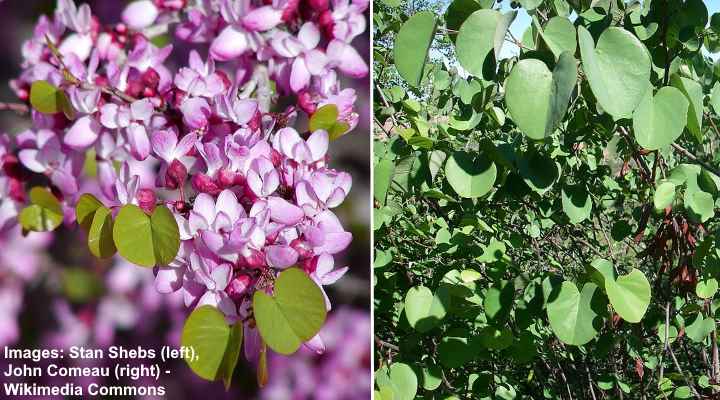
Western redbud flowers and foliage
Western redbud trees are multi-trunked small trees with pink flowers, magenta buds and green heart-shaped leaves. Western redbuds produce purple seed pods that keep their color throughout the summer. As a compact redbud tree, the Western redbud is an ideal border plant for small gardens. Native to California, Western Redbuds thrive in zones 6 – 9.
Judas Tree (Cercis siliquastrum L.)
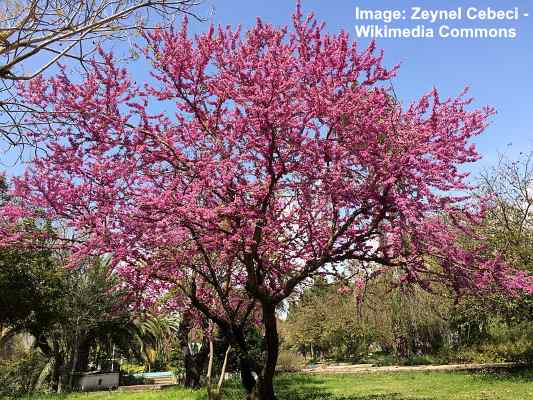
Judas tree (Cercis siliquastrum)
The Judas tree or European redbud is a variety of small redbud tree with rose colored flowers. The Judas tree is native to the Mediterranean. The ‘Mediterranean’ redbuds produce showy purplish-rose flowers, purple seedpods, and bronze and green foliage that add grace to sunny gardens.
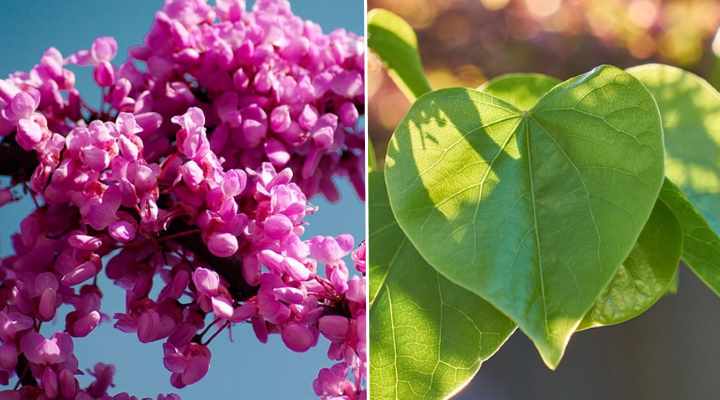
Judas tree flowers and leaves
The Judas tree grows up to 25 ft. (7.5 m) tall with a substantially rounded canopy. Leaves in the shape of hearts start as bronze, turn dark green in summer, then become pale yellow in the fall. This redbud variety thrives in zones 6 – 9.
‘Alba’ Judas Tree (Cercis siliquastrum ‘Alba’)
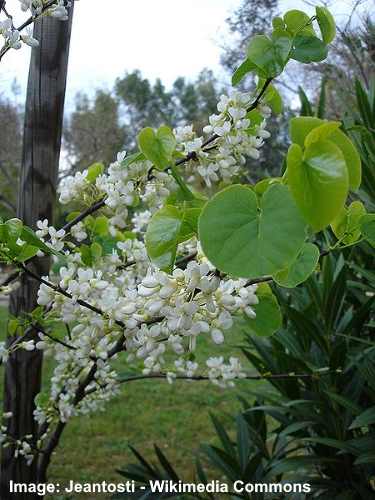
‘Alba’ Judas tree with white flowers
‘Alba’ Judas trees are deciduous trees with clusters of brilliant white flowers. The spreading tree has a round canopy, bushy foliage, and green kidney-shaped leaves that turn yellow in the fall. Grow this white Mediterranean redbud in full sun or partial shade. Mature ‘Alba’ redbuds grow up to 40 ft. (12 m).
Chinese Redbud (Cercis chinensis)

Chinese redbud tree and flowers
Chinese redbuds look like a rounded mass of pink or white color when in full bloom. Chinese redbud plants are shrub-like small trees that have circular, disc-like leaves. These Asian redbud trees grow up to 50 ft. (15 m); however, most varieties are like smaller colorful shrubs.
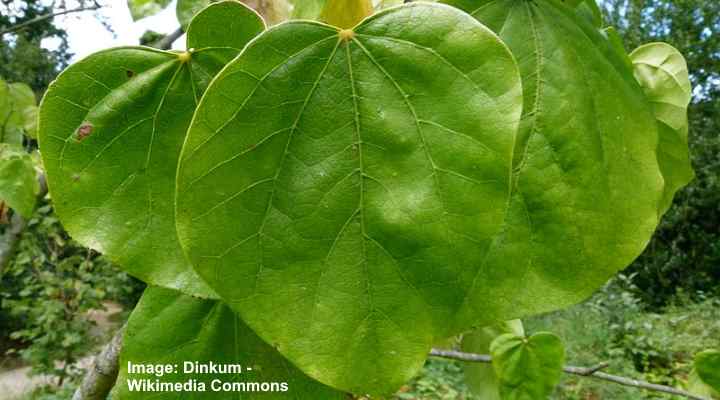
Chinese redbud leaves
Chinese redbuds’ characteristics are rosy-purple flower clusters, long purple seedpods, and round, glossy leaves that taper to a point.
Chinese redbuds thrive in zones 6 – 9 and grow well in full sun or partial shade.
‘Avondale’ Chinese Redbud (Cercis chinensis ‘Avondale’)
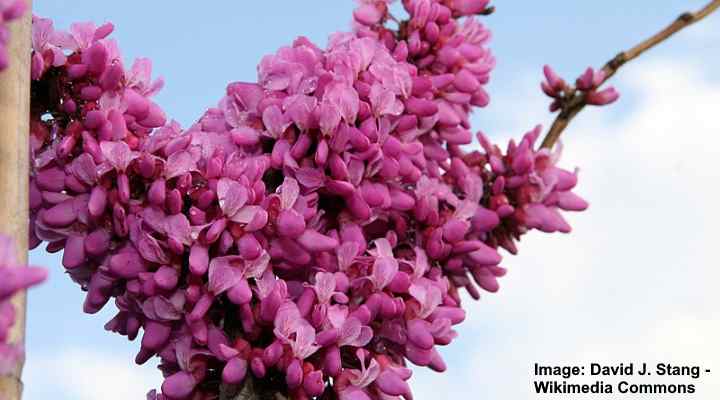
‘Avondale’ Chinese redbud flowers
Chinese ‘Avondale’ redbuds have dense clusters of rose-magenta flowers that bloom in spring. ‘Avondale’ redbuds produce a spectacular spring floral display in spring. Large glossy heart-shaped leaves start as red-purple, then turn green before turning yellow in the fall.

‘Avondale’ Chinese redbud leaves
From all of the redbuds, ‘Avondale’ Chinese redbud trees produce the most flowers. These redbuds are suitable for growing in shrub borders, as a specimen plant, or in containers.
Easy growing ‘Avondale’ redbuds thrive in zones 6 – 9 and in full sun.
‘Don Egolf’ Chinese Redbud (Cercis chinensis ‘Don Egolf’)
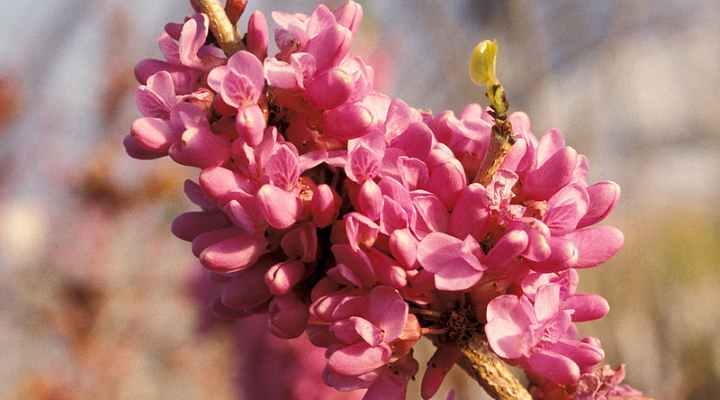
‘Don Egolf’ Chinese redbud flowers
‘Don Egolf’ Chinese redbud trees are small, slow-growing, compact trees or large bushy shrubs. ‘Don Egolf’ redbuds—like most redbud varieties—produce dense clusters of rosy-pink flowers along its branches. Heart-shaped glossy green leaves grow compactly on the branches.
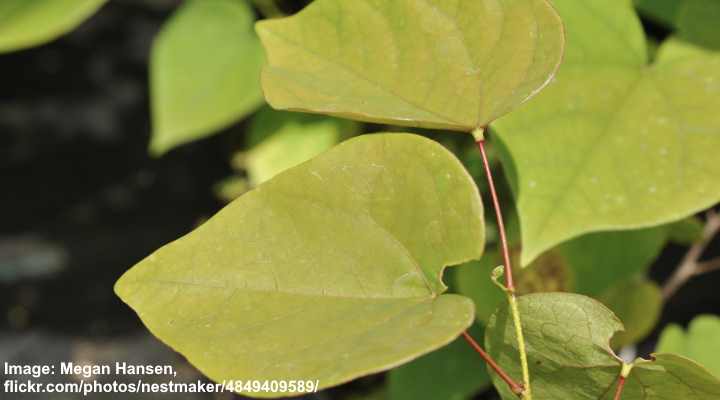
‘Don Egolf’ Chinese redbud leaves
‘Don Egolf’ Chinese redbud trees are unique in that they don’t produce seedpods. The 10-ft. (3 m) tall trees thrive in moist, well-draining soil, full sun, and in zones 6 – 9.
Eastern Redbud (American Redbud) Care
Generally, Eastern redbuds are easy-care shrubs or trees. Your redbud variety will bloom year after year with little maintenance, filling the branches with eye-catching clusters of pink, white, mauve, rose, or magenta flowers.
Here are a few care tips to help your Eastern American redbud to thrive:
- Plant redbuds in full sun or partial shade if you get scorching summers.
- Most species of redbuds prefer moist, well-draining ground that is moderately fertile.
- Prune young redbuds in the fall to develop the shape you desire.
Related articles:
- Types of Flowering Trees
- Small Trees for Landscaping Small Spaces
- Small or Dwarf Weeping Trees for Landscaping
